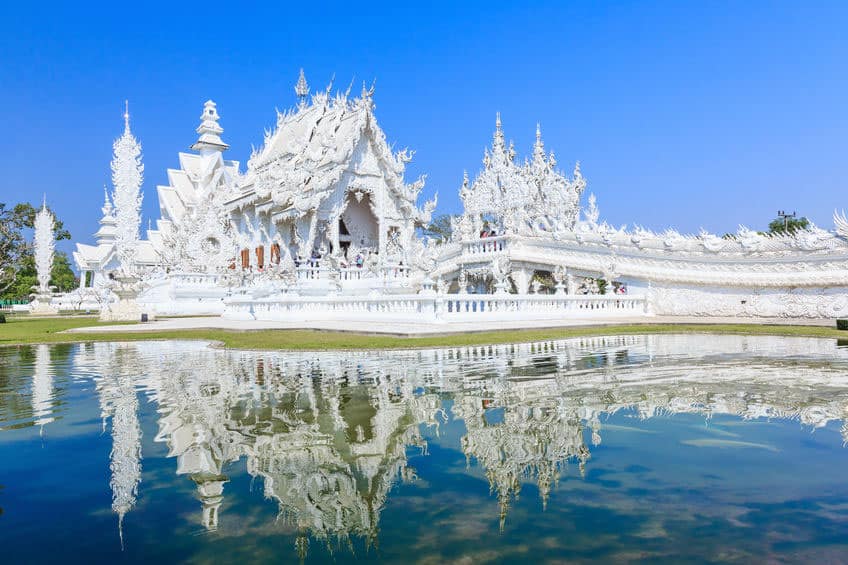
Thailand’s temples (called wats) are famous for a reason: glittering mosaics, towering spires, serene Buddha halls, and details so intricate you’ll wonder how anyone’s hands could possibly be that steady. The “problem,” if you can call it that, is that once you start browsing temple photos online… everything looks stunning.
So instead of tossing another giant list at you, this updated guide focuses on truly distinct temples—places that feel different from one another in style, setting, and story. I also checked that each site is currently operating and open to visitors, with the latest published hours/fees where available (note: hours and fees can shift on holidays and special religious days).
Quick pick: which temples should you prioritize?
If you’re short on time, these are the “most different from each other” picks:
- Bangkok classics: Wat Pho + Wat Arun + Wat Suthat (easy to pair in 1–2 days)
- Best day trip from Bangkok: Ayutthaya (Wat Chaiwatthanaram at sunset is magic)
- Most mind-bending modern temple art: Wat Rong Khun (White Temple), Chiang Rai
- Most “how is this real?” craftsmanship: Sanctuary of Truth, Pattaya
- Most epic sweat-for-the-view climb: Tiger Cave Temple, Krabi
- Most offbeat stop: “Buddhist Hell” at Wang Saen Suk Hell Garden (Bang Saen/Chonburi)
Temple etiquette and dress code (so you don’t get turned away)
Temples are living religious spaces—not just photo backdrops—so a little respect goes a long way.
Dress code (the big two):
- Cover your shoulders
- Cover your knees
If you forget (it happens), you’ll often find inexpensive cover-ups or “elephant pants” nearby. Some sites also loan or rent wraps.
Temple manners that locals appreciate:
- Remove shoes where posted (especially before entering prayer halls).
- Keep voices low; avoid running/jumping poses inside sacred areas.
- Don’t block worshippers or photograph people praying up close.
- Be mindful around monks (women typically avoid direct contact).
- When in doubt: step aside, observe, and follow the vibe of the room.
11 must-visit temples and temple-like landmarks in Thailand
1) Sanctuary of Truth (Pattaya) — the jaw-dropping wooden masterpiece
This one doesn’t look like a typical Thai wat—and that’s exactly why it belongs on your list. The Sanctuary of Truth is an enormous, intricately carved wooden structure that feels like a myth brought to life. Every angle has layers of sculpture—mythology, philosophy, and craftsmanship turned up to maximum.
Why it’s worth it
- The scale and carving detail are genuinely next-level.
- It’s one of those places where you keep saying, “Wait… the whole thing is wood?”
Visitor info (currently operating)
- Published as open daily, with daytime and night tour windows and posted ticket prices. sanctuaryoftruthmuseum.com
2) Wat Pho (Bangkok) — the Reclining Buddha and the “classic Bangkok” temple vibe
Wat Pho is Bangkok comfort food: iconic, beautiful, and somehow still impressive even when you’ve seen 100 photos of it. The Reclining Buddha is massive and gleaming, and the complex is packed with courtyards, chedis, and quiet corners that feel surprisingly calm for being so central.
Don’t miss
- The Reclining Buddha (and the mother-of-pearl feet details).
- Wandering beyond the main hall—there’s a lot more here than the headline statue.
Visitor info (currently operating)
- Published operating hours and foreign visitor ticket pricing are posted on Wat Pho’s official “Plan Your Visit” information. watpho.com
3) Wat Arun (Bangkok) — the riverside “Temple of Dawn” glow-up
Wat Arun sits on the Chao Phraya River and looks like it was designed specifically for golden-hour photos. The central prang (spire) is decorated with colorful ceramic and porcelain pieces that sparkle in the sun.
Pro tip
- Go early (cooler + fewer crowds), then ferry across and continue temple-hopping.
Visitor info (currently operating)
- Published as open daily, with an updated entrance fee listed by Thailand tourism sources. Tourism Authority of Thailand
4) Wat Suthat + the Giant Swing (Bangkok) — murals, old-city charm, and a legendary landmark
Wat Suthat is one of Bangkok’s most rewarding temples if you like giant interior spaces and detailed murals. It’s also steps from the Giant Swing, a famous old-city landmark with a wild history.
Worth doing
- Pair it with a slow walk around Old City—this area has a calmer, “real Bangkok” rhythm.
Visitor info
- Published visitor info (including hours and foreign admission pricing) appears on Thailand’s 2026 Annual Meetings site; note that specific areas (like museums) can have separate hours/fees. Thailand 2026
5) Wat Chaiwatthanaram (Ayutthaya) — sunset ruins that feel cinematic
Ayutthaya is the former capital, and its temples are the definition of “ancient grandeur.” Wat Chaiwatthanaram is a standout—especially late afternoon when the light turns the brickwork warm and dramatic.
Important update / correction
- The famous Buddha head entwined in tree roots is at Wat Mahathat in Ayutthaya—not Wat Chaiwatthanaram—so if you want that iconic photo, add Wat Mahathat to your route.
Visitor info (currently operating)
- Published opening hours (and evening/night visiting info when available) are listed on major travel listings for Wat Chaiwatthanaram.
6) Wat Phra That Lampang Luang (Lampang) — classic Lanna architecture, deeply revered
If you want a temple that feels traditional, historic, and spiritually significant—without the Bangkok crowds—this is a strong pick. It’s often highlighted as one of the best examples of Lanna-style temple architecture.
Visitor info
- Tourism Thailand listings publish it as open daily with admission information. Tourism Authority of Thailand
7) Wat Pa Maha Chedi Kaew (Sisaket) — the “Million Bottle Temple”
Yes, it’s real—and yes, it’s awesome. Also known as Wat Lan Khuad, this temple complex is famous for being built using glass bottles (and it’s far more beautiful in person than it sounds in a sentence).
Why people love it
- It’s quirky, clever, and genuinely artistic—not just a gimmick.
Visitor info (currently operating)
- Published as open 8am–5pm, with free entry/parking stated by Thailand travel sources. It’s better in Thailand
8) Wat Rong Khun (Chiang Rai) — the White Temple (modern, surreal, unforgettable)
If your brain likes “beautiful, but also… WHAT am I looking at?” this one’s for you. The White Temple is dazzling—bright, ornate, and packed with symbolism that ranges from spiritual to pop-culture-weird.
Pro tip
- Arrive at opening if you can. It’s popular, and the midday crowds can be intense.
Visitor info
- Published as open daily 8am–5pm, with an entrance fee noted by recent Chiang Rai travel guides. themanduls.com
9) Wat Pha Sorn Kaew (Khao Kho, Phetchabun) — mosaic mountainside magic
This is one of Thailand’s most striking modern temple complexes, set in the hills with cool air (by Thai standards) and sweeping views. It’s famous for its intricate mosaics and the five seated Buddhas lined up like a serene, sky-high family portrait.
Visitor info
- Multiple up-to-date travel sources publish it as open daily with weekday/weekend hour ranges, and generally free entry (donations welcome). homeiswhereyourbagis.com+1
10) Tiger Cave Temple (Krabi) — the “earn your view” staircase climb
This is the temple that turns into a mini pilgrimage for travelers: a steep climb (think 1,200+ steps) to panoramic views and a giant Buddha overlooking Krabi’s dramatic landscape.
Pro tips
- Go early (cooler, safer, prettier light).
- Bring water.
- Wear shoes with decent grip (you’ll thank yourself on the way down).
Visitor info (currently operating)
- Published opening hours are commonly listed as 6:00am–6:00pm by Thailand travel/airline sources.
11) Wang Saen Suk Hell Garden (Bang Saen/Chonburi) — the bizarre “Buddhist Hell” morality park
This is not your typical temple stop—and that’s the point. Near Bang Saen (Chonburi), this garden features vivid statues depicting punishments tied to moral lessons. It’s eerie, fascinating, and unforgettable in a “well, I’ve definitely never seen that before” way.
Visitor info (currently operating)
- Published opening hours are commonly listed as 6:00am–6:00pm on travel listings.
Easy itineraries to make this practical
Bangkok: 1-day “big hitters”
- Morning: Wat Pho
- Late morning: Ferry + Wat Arun
- Afternoon: Wat Suthat + Giant Swing
Ayutthaya: half-day or full-day
- Start with Wat Mahathat (tree-root Buddha head)
- Finish with Wat Chaiwatthanaram near sunset
North Thailand: 1–2 days in Chiang Rai
- Anchor stop: Wat Rong Khun (White Temple)
- Pair with other Chiang Rai temples if you want a full day
Krabi morning mission
- Sunrise/early AM: Tiger Cave Temple
- Reward yourself after: long lunch + beach time (you earned it)
Related questions (updated)
What do you wear to temples in Thailand?
Aim for modest, breathable clothes:
- Covered shoulders (t-shirt, blouse, light overshirt)
- Covered knees (long skirt, loose pants, long shorts are often not accepted)
- Easy-off shoes (you’ll remove them a lot)
Carry a thin scarf or wrap in your day bag and you’ll be set for almost every wat.
Do all temples charge admission?
Many are free (donations appreciated), but popular sites—especially major Bangkok temples and standout “special” places—often charge foreigners an entrance fee. Always keep a little cash handy.
What is the oldest temple in Thailand?
There isn’t one universally agreed “oldest temple in Thailand” because many sacred sites are extremely old, rebuilt over centuries, and tied to local tradition and legend.
What is accurate: Wat Pho is among Bangkok’s oldest temples, with roots that predate Bangkok becoming the capital.
